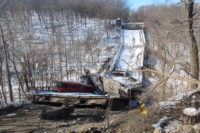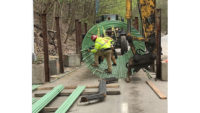NTSB Faults Maintenance, Inspection Oversight for Fern Hollow Bridge Collapse

A corroded transverse tie plate led to the collapse, say investigators.
Photo courtesy of NTSB
The City of Pittsburgh’s failure to act for more than a decade on repeated maintenance and repair recommendations regarding the Fern Hollow Bridge was the probable cause for the structure’s dramatic 2022 collapse, the National Transportation Safety Board (NTSB) said at its Feb. 21, 2024, meeting. The city is the owner of the bridge.
The NTSB cited the poor quality of annual inspections and insufficient oversight by the Pennsylvania Dept. of Transportation and other agencies among the incident’s contributing factors.
The determination was based on a 25-month investigation following the January 28, 2022, collapse of the 52-year-old, 447-ft-long, three-span K-frame weathering steel bridge, which sent a transit bus and several other vehicles tumbling approximately 100 ft into a ravine. There were no fatalities from the incident but nine people were injured.
The NTSB examined evidence that included field studies of the collapse site, materials testing and finite element analysis, interviews with city and state agency personnel and contract inspectors, and a review of design, fabrication and maintenance documentation, as well as video from the transit bus’s on-board cameras. Documentation from the investigation was made public in January 2024.
Inspectors traced the failure to a transverse tie plate in the structure’s southwest leg, which had significant corrosion and section loss due to water and road salt runoff from the bridge’s perpetually clogged drains. That prevented the formation of a protective patina around the area
Inspection reports and repair recommendations from required annual inspections from as early as 2005 documented the increasing deterioration, including the gradual expansion of a hole on the lower web of the leg from 2x4 in to 12x12 in, recorded on September 29 2021, approximately four months prior to the collapse.
The board said that the city largely failed to respond to inspection reports, although a 2009 rehabilitation plan, developed by Michael Baker Jr., Inc. under contract to the City of Pittsburgh did result in the installation of cross-bracing steel cables as a temporary measure to increase the bridge’s resistance to wind loading. Permanent measures were not implemented, however, nor did the city respond to many other recommendations, including one to apply a rust-inhibiting coating to the legs as lower bracing members.
As a result, the board concluded, the southwest leg eventually lost sufficient structural capacity to carry the bridge load at the time of the collapse.
“If the city of Pittsburgh had taken appropriate action to repair or reinforce the section loss on the fracture-critical bridge leg components,” the NTSB added, “the collapse of the Fern Hollow Bridge could have been prevented.”
Inspection and Oversight Inconsistencies
The NTSB also faulted processes for performing federally required annual and, beginning in 2014, interim yearly inspections, which were contracted and managed by PennDOT on behalf of the city. According to NTSB documents, Wilbur Smith Associates, Inc., carried out the inspections from 2005 until after its acquisition by CDM. Inspections were performed by the renamed organization, CDM Smith, Inc., from 2014 to 2019, and by Gannett Fleming, Inc., in the two years prior to the collapse.
In addition to procedural shortcomings, such as insufficient cleaning of corrosion before measuring section loss, “the contractors did not properly identify the bridge legs, including the transverse tie-plates, as fracture-critical members non-redundant steel tension members,” the NTSB found, a determination that would have trigged more in-depth, hands-on inspections. Instead, the bridge superstructure was rated as “5,” or Fair, from 2005 to 2011, after which it was downgraded to “4,” or Poor, a rating it maintained following the September 2021 inspection.
Both Gannett Fleming and CDM Smith have been named as defendants in civil lawsuits filed by several individuals injured in the collapse.
The fact that multiple contractors failed to properly carry out the inspections was evidence of insufficient PennDOT oversight of the city’s bridge inspection program, the board said, contributing to the bridge’s continued deterioration. Of note were inaccurate load rating calculations that did not directly account for the localized effect of section loss or cross-bracing, nor had engineers used the correct K factor to estimate axial load capacity.
The city’s poor paving records also failed to document that the bridge's asphalt wearing surface at the time of the collapse was approximately twice the 3-in design thickness. NTSB investigators determined that an accurate load rating analysis using correct calculations and assumptions, would've reduced the estimated load posting of 26 tons by nearly 90%, to 3 tons.
“Had the load rating calculation correctly accounted for these factors, the result would have required closure of the bridge,” the board said.
NTSB Chair Jennifer Homendy told reporters following the board’s meeting, that while responsibility for the bridge’s failed maintenance rests squarely with the city of Pittsburgh, action could have been taken at any level to address these issues.
“It was failure after failure after failure,” Homendy said.
The NTSB’s hypothesized failure mechanism “is entirely consistent with the evidence,” observes Roberto Leon, a professor of construction engineering at Virginia Tech, and a specialist in steel-concrete composite structures. In the end, he adds, the collapse was the result of a failure in existing checks and balances did not work because humans are involved.
“The whole system works well when all parties do their job,” Leon explains. “It is hard to ensure the reliability of the data in the bridge management system because much of the rating is subjective. The lesson here is that we need to be continually checking the processes.”
Strengthening Weak Links
The board noted that the City of Pittsburgh and PennDOT separately have already taken measures that “have the potential to address the deficiencies found in this investigation,” but stressed that the state agency should take the lead in evaluating the measure’s effectiveness for improving bridge safety.
Pittsburgh’s new bridge asset management program, launched in 2023, has increased bridge maintenance staffing, and established a funding stream that Mayor Ed Gainey says, increases the budget for maintenance and repair by 300%. The city has also worked with consultant WSP USA to perform a comprehensive evaluation of all city-owned bridges.
“We now know the state of every bridge we own and what is needed to keep our residents safe,” Gainey wrote in an opinion piece published following the NTSB’s meeting. “And, for the first time, we have a comprehensive investment strategy to help deliver the much-needed funding to take on these major infrastructure projects.
PennDOT likewise has “conducted reviews and analyses inform additional guidance regarding maintenance of weathering steel structures and procedures to increase the oversight of all bridges, which have been incorporated into our processes,” according to an agency spokesperson, adding that many of the NTSB’s post-collapse recommendations “have already proactively implemented.”
To aid other bridge owners in preventing the same lapses that led to the Fern Hollow Bridge collapse, the board issued recommendations to the Federal Highway Administration and the American Association of State Highway and Transportation Officials to address the safety issues identified in the investigation, including updating inspection guidance and training programs and refining bridge load rating practices.
The board also reiterated its May 2023 recommendation, since adopted by FHWA, for federal and state transportation authorities to take immediate action to resolve outstanding maintenance issues on uncoated weathering steel plate structures similar to the Fern Hollow Bridge.
The NTSB’s final report on the collapse will be published in several weeks.
In her closing remarks, NTSB Chair Homendy cited the 11-month process to design and build a replacement bridge at Fern Hollow as evidence that maintenance of existing infrastructure is often a secondary consideration.
“We cannot prioritize new construction over maintaining our nation's roads, bridges, and tunnels that we all traverse every single day,” she said. “It is clear that the Fern Hollow catastrophe was a serious wake up call for both the city of Pittsburgh and PennDOT. I hope it serves as a wake-up call to every other bridge owner and state. We cannot take our infrastructure for granted. Lives depend on it.”



